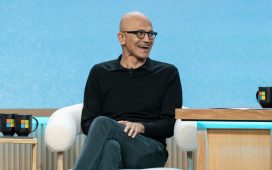Behind the scenes of every chipmaker, there’s a set of instructions that dictates how their products will function. Over the last three decades, Arm has become the dominant company making this chip architecture, and it powers nearly every smartphone today. Apple bases its custom silicon for iPhones and MacBooks on Arm, and now Nvidia and AMD are reportedly making Arm-based PC chips, too.
Arm’s blockbuster IPO in September valued it above $54 billion, thanks in part to the growing list of companies choosing Arm over Intel‘s rival x86 architecture.
On Wednesday, it beat Wall Street expectations in its first post-IPO earnings report, with revenue up 28% on an annual basis during the quarter. Still, revenue guidance fell short of expectations, sending Arm shares down more than 7% in extended trading.
The UK-based company sells licenses for its chip architecture to companies that make central processing units, or CPUs. It also collects royalties on every chip shipped with its technology. Haas says that number topped 30 billion last year. Its customers are the biggest names in tech and chips, including Apple, Nvidia, Google, Microsoft, Amazon, Samsung, Intel and Taiwan Semiconductor Manufacturing Company.
“Most people think about a device. Then maybe if they’re really sophisticated, they think about the chip, but they don’t think about the company that came up with the original ideas behind how that chip operates,” said Bob O’Donnell, president and chief analyst at TECHnalysis Research. “But once you do understand what they do, it’s absolutely amazing the influence they have.”
Arm enables chips to use less power than those made with x86. Lately, it’s seen a big surge in adoption.
Arm is the basis for Apple’s custom processors, which have replaced Intel chips in Macs. Amazon Web Services bases its custom server chips on Arm. Qualcomm’s flagship Snapdragon chips are also Arm-based, and getting ready to make a meaningful move into the PC market.
But Arm has also faced plenty of risks in recent years. About 20% of its revenue comes from China, according to the company. Smartphones, which almost all contain Arm processors, are seeing a major sales slump. And when Nvidia tried to buy Arm for $40 billion, the deal was blocked by regulators last year.
“That didn’t go the way that everyone anticipated or hoped that it would. But the sun comes up the next day, right? And you have to be able to build from that,” CEO Rene Haas told CNBC in an interview in October.
CNBC went to Arm’s headquarters in Cambridge, England, to find out how it became the year’s biggest IPO despite struggling smartphone sales and geopolitical uncertainty.
From smartphones to AI
Arm was founded in 1990 by 12 chip designers working out of a turkey barn in Cambridge. It was originally a joint venture between Apple, Acorn Computers, and VLSI, which is now part of NXP.
Arm’s big break came in 1993, when Apple launched its early handheld Newton device on the Arm610 processor. Haas said this gets at the “hallmarks” of the company. “We were born running a device off a battery that was going to be low cost,” he said.
Arm’s big break came in 1993 when Apple released its handheld Newton device on the Arm610 processor.
Arm Holdings
That same year, Arm struck a deal with Texas Instruments, putting its processors in early Nokia mobile phones and beginning Arm’s climb to become the dominant smartphone architecture it is today. Arm went public for the first time in 1998. Chief architect Richard Grisenthwaite was there.
“We were about 100 people, and I’ve been very much involved in this tremendous transition that the company has gone through, expanding out from being targeting one particular market area into a wide range of different computing environments,” Grisenthwaite said.
Indeed, Arm grew rapidly in the 2000s, with the first touchscreen phones introduced in 2007 and the growth of connected home devices in the 2010s.
Arm now has some 6,500 employees globally. Grisenthwaite said the majority of those employees are in the UK, and about a sixth are in the U.S., where Arm has offices in Arizona, California, North Carolina and Texas. It also has locations in Norway, Sweden, France and India.
In 2016, Arm once again became a private company when Japan’s SoftBank acquired it for $32 billion. Haas was president of the IP products group at the time, spearheading diversification into emerging markets, including AI.
“PC and phone, automotive, data center and IoT. Those are the primary markets that we address. Every single one of those markets has AI embedded in some way, shape or form,” he said.
Arm has some 6,800 patents worldwide, with another 2,700 applications pending. Some of those are for Arm’s Neoverse line for high-performance and cloud computing, which has helped it break into AI since its launch in 2018.
In August, Nvidia announced its latest Grace Hopper Superchip, which couples its own GPUs with Arm’s Neoverse cores.
“By bringing those together and tightly coupling the way that Nvidia has with the Grace Hopper, they’re able to come up with something that’s something like 2 to 4 times the performance of what you’d get on an x86 system for a similar amount of power,” Grisenthwaite explained.
Cash and competition
If you rewind just a couple years, Nvidia’s interest in Arm went far beyond technology integration. Arm owner Softbank needed cash after losing money on high-profile investments in companies like WeWork and Uber. In 2020, SoftBank struck a deal with Nvidia to sell Arm for $40 billion. Eighteen months later, the deal fell apart, blocked by regulators and some of Arm’s biggest customers, which also compete with Nvidia.
Haas said he was, “Disappointed it didn’t happen just because we spent so much time on it.”
Instead, Softbank announced plans to take Arm public again and Haas took over as CEO.
Arm CEO Rene Haas talks with CNBC’s Katie Tarasov in San Jose, California, on October 12, 2023.
Katie Brigham
Arm made its second public debut this September, climbing nearly 25% that day.
The stock has fallen significantly since then.
One risk comes from a free, open-source rival architecture called RISC-V. It’s seen a recent surge in backing from some of Arm’s big customers like Google, Samsung and Qualcomm, which may have been seeking alternatives when it looked like Nvidia was going to buy Arm.
For now, RISC-V remains a low risk competitor according to Futurum Group CEO Daniel Newman.
“RISC-V sits a few years behind where Arm is at, and I don’t think we’re going to hear a lot about it right away. I do think in low power, in IoT, in simpler designs, that RISC-V does have some traction,” Newman said.
Arm’s bigger competition comes from x86. Developed by Intel in the 70s, x86 is the dominant architecture used for PC processors, with a massive amount of software developed for it.
“The amount of software support is the thing that actually tends to determine the success or failure of that in the long run. Intel was very good early on with getting a ton of software support for x86,” O’Donnell explained.
Most servers have also traditionally been based on x86, but O’Donnell said that could shift.
“What’s happened in the server market is that the software has been componentized. It’s broken up into containers and things like that, and that makes it easier to run on other architectures like Arm,” he said.
Amazon Web Services is a big player making Arm-based server chips. AWS launched its Graviton chips to rival x86 CPUs from AMD and Intel in 2018.
“And really from there, Arm went from this mobile, low power IoT, automotive specialty embedded to holy cow, we can build next generation servers, PCs, and of course continue on this massive run of silicon for smartphones, all based on Arm,” Newman said.
‘If Apple can do it, can others?’
Apple is the big partner helping Arm break into the laptop market.
Apple moved to its own Arm-based processors in Mac computers in 2020, breaking away from the Intel x86 processors that had powered them for 15 years.
In October, Apple announced its latest line of M3 processors and the MacBooks and iMacs running on them. Apple said Arm-based M3 gives the newest MacBook up to 22 hours of battery life.
“Nobody really believed, until Apple went all in and basically cut ties with x86 instruction sets and said, ‘We are going to bet the future of the Mac on Arm.’ And that was a huge inflection for the company. It was a change of the guard. And this isn’t to say that Intel’s future is in big trouble, but it certainly started to raise some question marks as to, well, if Apple can do it, can others?” Newman said.
In September, Apple extended its deal with Arm through at least 2040.
Qualcomm is another major customer making its latest PC processors using Arm, although that relationship is strained. Arm is suing Qualcomm over the right to make certain chips with its technology. The issues started after Qualcomm acquired CPU company Nuvia in 2021, and with it, Nuvia’s Arm license.
“Nuvia was actually supposed to be designing a server chip initially, so they had different terms with them. And so Qualcomm thought they could have the same terms. Arm felt no, different companies have different terms. And it’s boiled down to essentially that: legal discussions around what those terms ought to be,” O’Donnell explained.
The case is set to go to trial in 2024.
Arm is also growing in the automotive space. Although its chips have long been in cars, it’s now a rapid growth area with the rise of self-driving capabilities and partnerships with companies like Cruise.
Arm’s Grisenthwaite calls self-driving “one of the most computationally intensive tasks we’ve ever seen on this planet.”
“What we need to provide is a standard platform to allow the world’s software developers to really concentrate on this incredibly hard task going forward,” he said, while demonstrating the AVA developer platform, which brings multiple self-driving components together to function on a single processor.
This simplification is also making Arm the choice for non-chip companies like Apple, Amazon, Google and Microsoft designing their own custom silicon.
“They’ve got a smaller team than entire companies built on that. And so you have to make that process easier and simpler. And that, for example, is where Arm is starting to move in terms of enabling the design of multiple components that connect together,” O’Donnell said.
Arm Holdings headquarters in Cambridge, England, on October 3, 2023.
Max Thurlow
‘China is a good market for us’
Although more companies are making inroads into semiconductor design, the recent chip shortage exposed major concern over the fact that more than 90% of the world’s chips are manufactured in Asia.
Now China and the U.S. are going back and forth imposing export controls on chip technologies. For now, Arm says it’s seen minimal impact from the export controls.
“What we do is obviously comply with all kinds of export regulations whenever they come out. Of course we comply. China is a good market for us: about 20% of our business. It’s shifted over the years. It used to be largely mobile phone based. Now it’s mostly around the data center and automotive,” Haas said.
In 2018, SoftBank broke off Arm’s China business into an independent entity, Arm China, that’s majority owned by a group of Chinese investors.
Haas explained further, “It’s essentially to allow us to not only grow our business in China, which is our essentially base core business. We set up a distributor arm, but at the same time, we also created an R&D arm that allows an independent entity to develop products specifically for the China market, some that are Arm based but some that are not Arm based.”
Arm China has also been embroiled in controversy, with SoftBank and Arm trying to oust the CEO of the China business, Allen Wu. Despite being fired, Wu refused to leave for years.
“It’s been very ugly and kind of messy and confusing,” O’Donnell said.
Now, several former Arm China employees are starting a new internal chip design company in China with backing from Shenzhen’s government. Arm’s stock slid more than 5% on the news, but O’Donnell said it’s not an immediate risk.
“A lot of Chinese companies have long standing relationships with Arm, so the expectation is they’re going to want to work there because they have that huge base of software. If somebody creates a new architecture, they have to build the software, and that takes years and years and years,” he said.
Arm also faces some risk from the major slump in smartphone sales.
“We’re not as impacted as folks might think because one of the trends we’ve seen, particularly in smartphones, is more and more Arm processors that go into those phones,” Haas said. “So for us, we’ve actually seen an increase in royalty per phone.
Labor is another challenge across the industry. The world’s chip leader, TSMC, is blaming a shortage of skilled workers for delays at its $40 billion fab under construction in Arizona.
“It’s hard for our whole industry because there’s no way that demand for semiconductors in the next 10 to 15 years will abate. It’s only going to increase. So it’s a pretty fierce talent war,” Haas said.










